Raincoast Research Sea Lice Studies
In 2011, Raincoast documented the first sea lice epidemic on juvenile wild Pacific salmon in Musgamagw Dzawada’enuxw Territory. Over 90 per cent of this salmon generation failed to return to spawn.
This collapse triggered the BC government’s Pink Salmon Action Plan – to remove farmed salmon, i.e., fallow the farms from the wild salmon migration route through the archipelago during the spring migration of young salmon past the farms.
The generation of salmon that went to sea that year had very few sea lice (Morton & Routledge, 2005) and their survival was “exceptionally” high (Beamish, et al., 2006).
Despite these findings, this management action was never repeated.
Negative Impacts on Wild Salmon
Later publications by Raincoast Research and others measured the direct relationship between the number of sea lice on wild salmon before and after and exposure to salmon farms.
Studies also examined how many lice it takes to kill a young wild salmon, with the resulting negative impact on wild salmon populations.
Pressure from scientists, First Nations, and environmentalists forced action to be taken to reduce sea lice on the farms. Although this worked for 7 years to protect the wild salmon, sea louse numbers have shot up again, causing the Musgamagw Dzawada’enuxw Nations to lose 39 per cent of young salmon migrating from their territorial rivers in 2015.
To date, no country or company has found a way to stop farm salmon sea lice from killing wild salmon.

